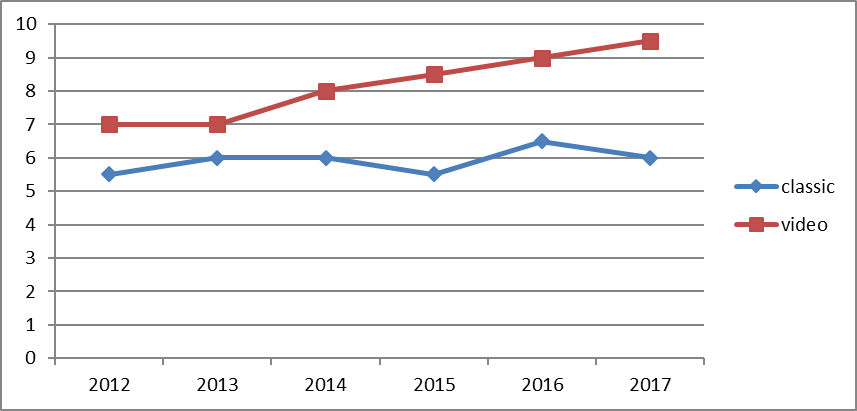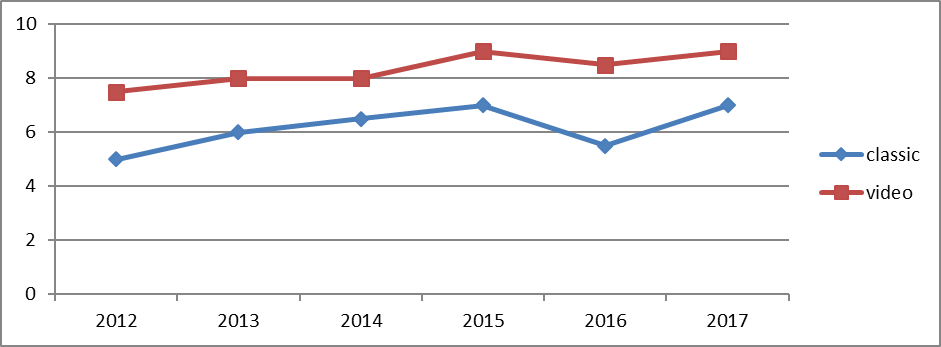Abstract
The importance of acquiring the gymnastics-specific terminology, a basic component in the professional development of UNEFS students, is evidenced by the very existence of terminology since the 17th century, a period when physical education schools were created. Collecting observational data, we note that reducing the duration of frontal training (from 8 to 3 semesters), because of the Bologna system, has generated, from this point of view, problems in the professional activity of the graduates, which is revealed by the negative feedback found in the preparation of their pupils (UNEFS students in the first year). The aim of this study is an attempt to solve the contradiction between the limited time for frontal training and the correct learning and use of the gymnastics-specific terminology. We have introduced, since 2012, a video exam (“Describe terminologically what you see”) in the assessment of students’ professional training, similar to the judge exam used by the International Gymnastics Federation, along with the classic one (“Present exercises for ...”). For the past six years, the exam scores obtained by students in the third year at the Faculty of Physical Education and Sports (Bachelor’s degree) and the first year at the Faculty of Kinetotherapy (Master’s Degree) have been recorded. The obtained results, as revealed by a simple statistical analysis, are contradictory. In the video exam, the scores have risen to the maximum, while in the classic one, the percentage exceeding the average level is insignificant.
Keywords: Terminologylearninggymnastics
Introduction
The gymnastics-specific terminology is part within the general concept of terminology. This is defined as “the totality of specialised terms used in a science, discipline, practical activity” (Constantinescu-Dobridor, 1998), or similarly, “all the terms used in a discipline or in a branch of activity” (DELR, 2016).
Terminology provides universal communication in a specialised field (Popescu, 2017). For this purpose, it needs to be precise, clear, concise and international (Podlaha et al., 1989).
The evolution of gymnastics-specific terminology is particularly visible in its competitive branch (Grigore, 2001).
Speaking of the importance of the gymnastics-specific terminology, we start from the fact that this is the basis of the terminology of physical education (Stroescu & Podlaha, 1974). At the same time, its coverage extends to sports field (Hidi, 2007).
The tendency of foreign authors is to focus the terminology of physical education and sports on one concept – sports terminology (Siedentop, 2007; Room, 2010). A controversial aspect is the confusion of the concept of physical education with fitness (Corbin, Corbin, Welk, & Welk, 2004), with the corresponding negative implications on the use of correct terminology.
Problem Statement
The study is based on the observations made over time after the transition from 8 semesters to 6 semesters (the Bologna model). The frontal activity dedicated to the learning and correct use of the gymnastics-specific terminology has been reduced from 8 to 3 semesters, which means, in units of time, from 224 to 84 hours.
For the UNEFS graduates, this reduction has created communication problems with the pupils in schools where they work as physical education and sports teachers. Problems are visible through the negative feed-back of their pupils who become students in the first year and do not know the notions of specific terminology. This is why much time is lost to acquire it, and there is a vicious circle about the reduced time of frontal activity and the need to practice the correct use of terminology.
But the Bologna system provides students with enough time for individual training to deepen the aspects they consider essential to their professional development.
Research Questions
Does video exam help or not in correct use of gymnastics-specific terminology?
Purpose of the Study
The purpose of this study is an attempt to flatten the contradiction between the limited time for frontal training and the need for the correct use of the gymnastics-specific terminology.
Research Methods
Our attempt guides the independent activity of students so that they exercise the correct use of the gymnastics-specific terminology based on video materials (because of their limited access to the gym).
The subjects of the study are third-year students at the Faculty of Physical Education and Sports (FEFS) – Physical and Sports Education Program (Bachelor’s degree) and first-year students at the Faculty of Kinetotherapy (FKT) – Nutrition and Body Remodelling Program (Master’s Degree).
The International Gymnastics Federation has also introduced a video test in the exam for international judges, which evaluates the association of terminological notions with the appropriate execution of the competition routines.
According to this model, since 2012, a video subject (“Describe terminologically the exercises you see”) has been introduced in the year exams, along with the classic subject (“Present exercises for...”), The results achieved by students on the two subjects were recorded over 6 years, the obtained data being processed by a simple statistical analysis based on arithmetic means and the graphical analysis method. Student performance was expressed in points from 0 to 10, as follows:
Present 10 exercises;
Each correctly presented exercise (initial position, movement, segment, direction, rhythm unit, final position) – 1 point;
Errors in showing the initial position – 0.5 point deduction;
Errors in presenting the correct sequence – 0.3 point deduction;
Errors in showing movements, segments, directions – 0.1 point deduction;
Lack of initial position – 0 points. Even in the case of correct presentation of the initial position, the accumulated subsequent errors can generate a score of 0 points.
Findings
Over the years, the number of students was variable. The arithmetic means obtained by them in the two tests of the exam are shown in Table
The professional evolution of students, from the perspective of the correct use of the gymnastics-specific terminology in the assessment for both the classic and video methods, is shown in Figures


The graphical analysis shows a higher level of the results obtained in the video exam. Over the years, the average results in this test have the tendency to increase near the maximum score compared to the classic test results, which do not exceed the average of 7 points.
There are no relevant differences between the results of students of the two faculties.
Conclusion
The video exam helps students to correctly use the gymnastics-specific terminology. The increased average results demonstrate the appropriateness and correct use of terminology.
This is in contradiction with the lack of performance in the case of classic examination.
We can assume that their attention is increased and focused, in the case of the video test, but in the case of the classic test, the stereotypes come into play, usually non-specialised language.
Consistent practice is required to use video materials associated with video making by students, based on the gymnastics-specific terminology (making video projects using the correct terminology – with a “script”).
References
- Constantinescu-Dobridor, Gh. (1998). Dicţionar de termeni lingvistici. Bucureşti: Teora.
- Corbin, C., Corbin, W., Welk, G., & Welk, K. (2004). Concepts of physical fitness. New York: McGraw-Hill Companies.
- DELR (Dicţionarul explicativ al limbii române). (2016). Bucureşti: Univers Enciclopedic Gold. [Academia Română, Institutul de Lingvistică “Iorgu Iordan - Al. Rosetti”].
- Grigore, V. (2001). Gimnastică artistică. Bazele teoretice ale antrenamentului sportiv. Bucureşti: Semne.
- Hidi, I. L. (2007). Fitness. Programe pentru optimizarea condiţiei fizice. Bucureşti: Editura Didactică şi Pedagogică.
- Podlaha, R., Hidi, I., Bedö, C., Solomon, M., Popescu, G., & Grigore, V. (1989). Curs de gimnastică (Partea I. Gimnastica de bază). Bucureşti: IEFS.
- Popescu, G. (2017). Metodica predării gimnasticii în şcoală. Bucureşti: Discobolul.
- Room, A. (2010). Dictionary of sports and games terminology. Jefferson, North Carolina and London: McFarland & Company, Inc. Retrieved from https://epdf.tips/dictionary-of-sports-and-games-terminology.html
- Siedentop, D. (2007). Introduction to physical education, fitness and sport (6th ed.). New York: McGraw-Hill Companies.
- Stroescu, A., & Podlaha, R. (1974). Terminologia gimnasticii. Bucureşti: Editura Didactică şi Pedagogică.
Copyright information

This work is licensed under a Creative Commons Attribution-NonCommercial-NoDerivatives 4.0 International License.
About this article
Publication Date
16 February 2019
Article Doi
eBook ISBN
978-1-80296-054-9
Publisher
Future Academy
Volume
55
Print ISBN (optional)
-
Edition Number
1st Edition
Pages
1-752
Subjects
Sports, sport science, physical education
Cite this article as:
Hidi, I. L., & Dina, L. A. (2019). Video Exam: Good Or Bad In Correct Use Of Gymnastics-Specific Terminology?. In V. Grigore, M. Stănescu, M. Stoicescu, & L. Popescu (Eds.), Education and Sports Science in the 21st Century, vol 55. European Proceedings of Social and Behavioural Sciences (pp. 401-405). Future Academy. https://doi.org/10.15405/epsbs.2019.02.50
